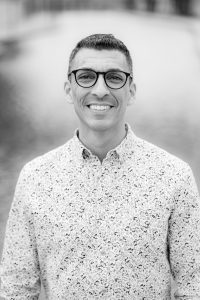Candidate Trae Blanco

Butler University
Director of University Bands
Biographical Statement with CBDNA Involvement
Dr. Trae Blanco serves as Director of University Bands at Butler University where he conducts the Wind Ensemble, teaches undergraduate and graduate conducting, and administers the band area. After completing his BME at New Mexico State University (NMSU), Dr. Blanco has served as Director of Bands at Las Cruces High School. Dr. Blanco holds a DMA in wind conducting from the Herberger Institute at Arizona State University, and a MM in Wind Conducting from the Jacobs School of Music at Indiana University. Prior to coming to Butler, Dr. Blanco served as Director of Bands at Murray State, and the University of Southern Maine. In July 2015, Dr. Blanco was a guest conductor with the United States Army “Pershing’s Own” Concert Band in Washington, D.C. and in both 2015 and 2016 Dr. Blanco was a finalist in the American Prize in Wind Conducting. Dr. Blanco has published articles with the NBA and WASBE journals and has been an invited presenter at the state conventions of West Virginia, Maine, Kentucky, Ohio, New Mexico, The Midwest International Band and Orchestra Clinic, College Band Directors National Association Eastern Division and North Central Division, as well as the 2019 WASBE International Convention in Bunol, Spain, and the upcoming 2024 conference in Soul, Seoul, South Korea.
Prior to my current appointment, we often hosted an honor band weekend that conflicted with the regular CBDNA conference schedule and thus, my participation was limited. Now with the freedom to plan for a spring semester without that commitment, I am eager to serve in this capacity. My attendance to the Midwest Clinic and WASBE conventions have been annual due to my lack of conflicts with those conferences, and I know that my service to CBDNA will greatly increase with this added flexibility.
While my service has been limited, I have had the opportunity to serve on the jury panel for regional and national conference submissions, and this year presented a session at the North Central Division as well as submitted student participants for the Intercollegiate Band. I am eager to submit additional presentations for both the National and Regional conventions in years to come, as well as performance submissions with the Butler University Wind Ensemble as well.
Vision for the Future of CBDNA
Most recently, the CBDNA Ad-Hoc Committee proposed an updated vision statement that separates the goals of the organization into three main threads; artists, leaders, educators, and capitalized on the addition of diversity, equity, inclusion, and access to music through our organization. My background as a public-school teacher, graduate student, professional conductor, and university faculty member have all formed my experiences to contribute to the discussion of where this organization can GROW in the coming years.
My vision for CBDNA is that the make-up of our organization begins to shape and adapt to represent the growing diverse student populations each of us serve. After viewing the listings for all the committees that make up our national organization, as well as regional leadership, I discovered only two Spanish speakers on the roster. Last year, the total undergraduate population of Hispanic students was nearly twenty percent. I believe that through the promotion of our organization in multiple languages, having the ability to provide CBDNA board and committee members for conferences who can provide translations are only the tip of the iceberg in our mission to diversify our organization.
With worldwide companies like Yamaha and Conn Selmer making efforts to build educational bridges and collaborations worldwide, how can we make ourselves available through vetted, qualified, multi-lingual professionals in the field who can partner, collaborate, and contribute to this global stage to life us from our silo of collegiate band programs? I believe the first step is to assess our resources, advertise their value and expertise, and partner with these companies to bring our organization to the global stage.
Finally, having served as a member of the small-school task force in its infancy in 2016-2017, my work at a regional state institution, and now my tenured position at a private university, I believe my experience to be insightful for many different types of universities, not just those needs of an R1. Our efforts of diversification are well intended, but the only way we can create a path forward to regional and national presidency for a broader candidate slate is through the discussion, inclusion, access, and equitable makeup of our committees that make up our organization, including members at large on the National Board.